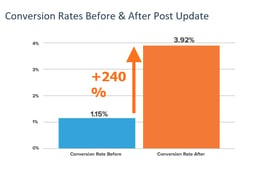3 powerful inbound marketing tips for training providers
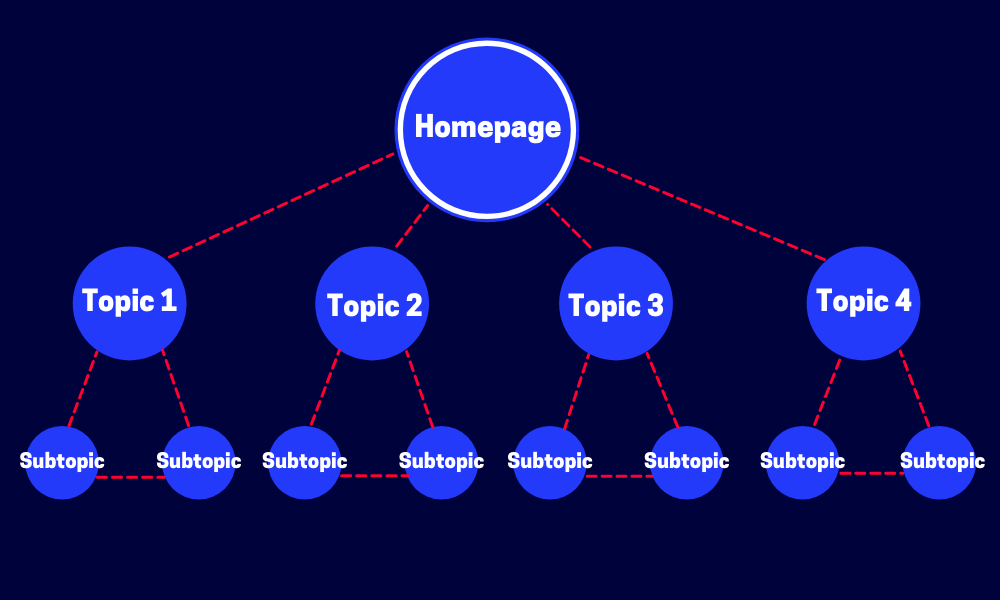
At Everest Virtual Training Industry Conference 2021, we had the great privilege of welcoming a number of amazing speakers to our virtual stage, delivering expert insight from the training industry, including tips for growing your training company.
Rikki Lear, Director of successful marketing agency Digital-22, delivered an insightful talk to our Everest audience discussing 3 key inbound tips for training providers in 2022.
.png?width=100&name=New%20Project%20-%202021-08-26T122956.247%20(1).png) Rikki Lear, Director at Digital-22
Rikki Lear, Director at Digital-22
Watch the webinar:
This blog summarises the key takeaways from Rikki's talk at Everest Conference 2021. Paraphrasing has been used to aid the flow of the content.
What is inbound marketing?
Inbound marketing is a strategy used to help attract, convert and close new business through 'pull' channels such as blogs, content marketing, SEO, social media and events.
In contrast, outbound marketing is a proactive approach that focuses on 'push' techniques, typically seen as interruptive, such as cold calling and emailing prospects.
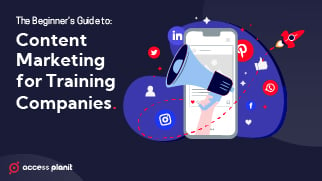 Download guide
Download guide
The inbound buyer's journey
In order to improve an inbound strategy, we first need to understand what the buyers journey looks like in the first place.
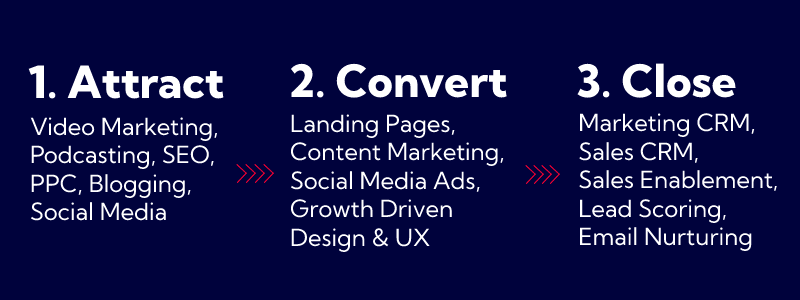
The success of an inbound strategy relies on effective marketing across the whole buyers journey. Above, we can see the process and methodology of inbound marketing, first coined by HubSpot over 10 years ago. The process hasn't changed much in this time, however the channels and tactics we employ certainly have changed (and will continue to), in order to move our target through the funnel.
Attract
The attract stage is all about getting the attention of, and attracting strangers and turning them in to visitors on one of your digital estates, typically your training website.
Convert
Once we are present in the mind of our visitors, we want them to convert in to leads. This step relies on building trust and authority, and ultimately, a connection between your training organisation and them, in order to encourage them to exchange contact information.
Close
In the close phase, there is often some back and forth with a lead or opportunity reliant on a number of touch points, as they are nurtured on their way to sale of a training course.
How to get ahead of the competition with inbound marketing
Now we understand what the inbound buyers journey looks like, how can we develop this in order to increase course bookings?
1. Think holistically
Have a 'what's next' approach
What is my expectation of want the user to do next? What action do I want them to take?
For example, you've just created a post for social media. What do you want the viewer of the post to do, and how can we improve this journey and turn them in to a visitor?
Poor:
See the social post >> Read it >> Continue scrolling
Better:
See the social post >> Read it >> Click through to your website
Best:
See the social post >> Read it >> Click through to website >> Strong call-to-action leading to premium/more in-depth content >> Becomes lead
It shouldn't be too hard to see in the examples above the impact of a 'what's next' approach can have when creating content.
Build a 'marketing to sales' funnel
Another way of becoming more holistic within your inbound marketing is to build a 'marketing to sales funnel.' This essentially sets tangible expectations of what you want to achieve, and allows you to analyse in which areas you can get better.
Many businesses don't take the time to look at all of the moving parts in the funnel below, and, if leads or opportunities are down, see it as a given that they must increase visitors numbers/training website traffic. However, that's not always the easiest, or most appropriate objective.
Increasing conversions of contacts you already have in your CRM through a well-designed nurture strategy could be a better initiative, or a paid remarketing campaign looking to transition hot leads through to opportunities.
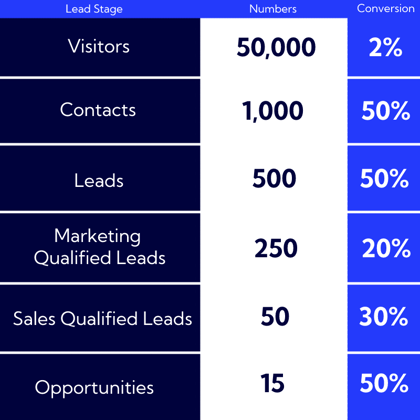
Map out your buyer's journey
We've looked above at the inbound buyer's journey, but it's also worth taking a step back and looking at what's required of us at each stage of the broader purchasing process, in order to tailor our training content and information to our audience who are at different stages in the cycle. Someone in the awareness stage will not be receptive to content that's designed for opportunities in the decision stage, and vice versa. Being holistic means being aware of this, and providing the right information, to the right audience, at the right time (and via the right channels!)
- Awareness - Key to driving traffic
- Awareness based marketing is all about getting noticed by visitors, and filling the top of the funnel.
- Consideration - Key to MQL (Marketing Qualified Lead) generation
- Consideration based marketing is all about qualification and conversion through more targeted and specific marketing practices. An example of this is running paid ads around your training course.
- Decision - Key to SQL (Sales Qualified Lead) generation
- Decision based marketing is about generating qualified or sales ready leads and encouraging opportunities in the funnel that you are the training provider of choice.
2. Make it personal
Build trust, be human
People do business with humans, and this needs to come through in your marketing!
Be the personality or company people know within the training industry.
Building trust is the most critical element in getting people to interact, or take action, with any marketing you do.
Have a 'video first' approach
Put your personality at the centre of your communications.
Start geeking out hard on video opposed to text. Use video everywhere within your business. Brian Halligan - CEO & Co-founder, HubSpot
The many uses of video
-
Rehumanising the sales process
One of the hardest things for a salesperson to do in the modern world is to stand out and be heard above the noise.
Digital-22 use video throughout the sales process in order to re-humanise the sales process and this has helped them to convey authenticity, trust and boost responses rates by 5 times! -
Marketing
Whether you're creating a social media post, narrating one of your recent training blogs or popping up on a landing page, there's several opportunities for creating great videos in your marketing content.
Digital-22 regularly use video surrounding webinars that they're running, both to help encourage registrations and to reach out to speakers asking if they'd like to speak at the event! -
Client services
Video is a great tool for training clients that you already have that relationship with, and allows complex or intricate ideas or solutions to be conveyed in a more engaging and easier to digest way.
Digital-22 use video when talking customers through complex reports or site audits in order to help them be more data centric and avoids having to create graphs with annotated notes.
What happens if you get it right
Below are some of the transformations Digital-22 have experienced first-hand from their transition to a 'video-first' approach:
- Increased website traffic
- 63% increase in form submissions
- 10% increase in pricing downloads
- Shorter sales cycle
- Faster hiring of new staff
- Employee NPS increased to +63
- Cut meeting agendas in half
3. Be the source of knowledge on a 'topic'
SEO and organic marketing involve a great deal of resource (and patience) in order to see results, however they are recognised as the biggest source of traffic and revenue for almost every client Digital-22 work with.
Search has changed
Search engines are far more sophisticated than they used to be. Previously, users would search for one or two words in their query and Google would make a semi-educated guess on what the searches intent was in order to display relevant results. But technology has advanced a great deal since then, particularly over the past 10 years.
- Queries are becoming longer and more complex
- We ask much more 'conversational' questions, and Google often has the answer
- We rely on search engines to understand context
The key is to start thinking in terms of TOPICS you want to own, not just KEYWORDS
What's the upshot of all of this? Well, the way we think about, plan and structure training content needs to change. We can no longer be robotic in our attempts to keyword-stuff our content or 'play the algorithm' - we need to become topic experts, and do our best to position ourselves as experts and answer every question our searcher has on the topic they're looking for.
So, how do we do this?
Topic clustering
First, let's talk pillar pages. Pillar pages sit at the heart of a topic cluster. It's what brings all of our cluster content together in to a central hub. It's the tree to our many branches. The page serves to broadly answer every question on the searchers topic. The 'Topic 1, Topic 2's' in the image below are what we would call pillar pages.
Cluster content could be thought about the niche questions searches look for around the main content. Internal links would link this content to the pillar page. In the image below, these are described as 'subtopics'.
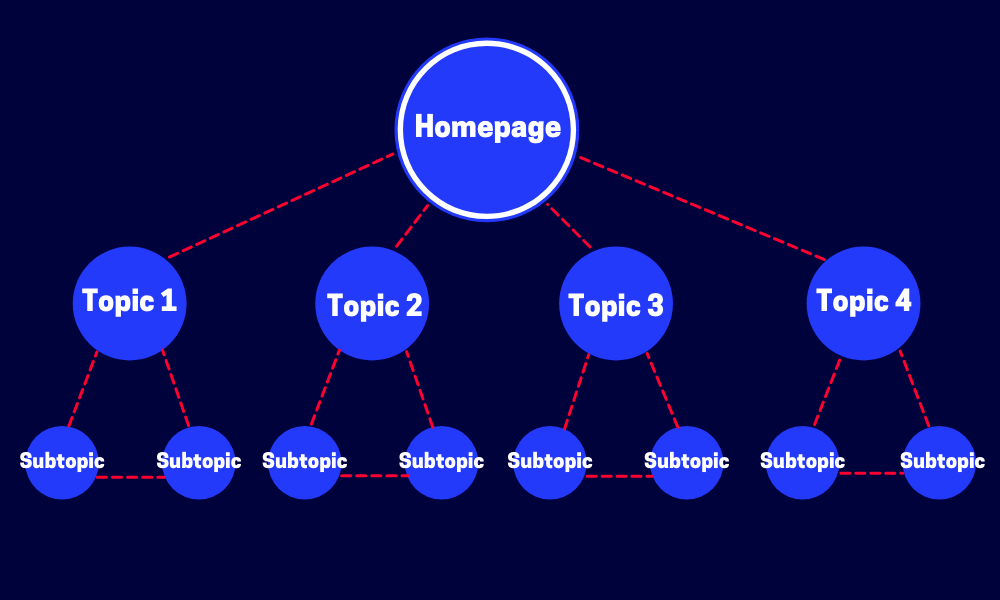
The benefits of topic clustering for training providers
There's a number of benefits to topic clustering, including:
- It answers the questions of your audience
- Improves user metrics & keeps people engaged
- It attracts links
- It helps you rank higher & get more organic traffic
- It helps you find gaps in your content strategy
- It gives your content purpose
- It helps sales
What happens if you get it right
It's important to remember that when creating new content, it takes time to see results, typically 6 months plus to see small changes, but 12 months before your new strategy can be properly reflected on and where tangible results can be seen.
Percentage increases can be exponential. It's not uncommon to see traffic increases of 200% or 300% following your first 12 months of topic clustering.
Key inbound takeaways for training providers
-
Think holistically
-
Have a 'what's next' approach
-
Build a 'marketing to sales' funnel
-
Map out your buyer's journey
-
-
Make it personal
-
Build trust, be human
-
Have a 'video first' approach
-
-
Be the source of knowledge
-
Recognise the changes to search
- Use topic clustering
-
Q&A on inbound marketing for training providers
Q: What advice would you give training providers in order to increase traffic and conversion rates?
RIKKI: "The fantastic thing with training and education providers is that it really suits itself to educational content - like that's the business, that's what you're in there to do."
"When we've gone in and worked with companies that have had things like syllabuses, perhaps like a pdf document highlighting what you'll learn in our course - the way we do it is we make that a web page and then we'll build outwards from there. If you think of that pillar approach above, you can expand on each of the bullet points in the syllabus, and build them into a topic cluster."
"An typical example for us could be - the first thing you're going to learn is SEO, and you can link to the cluster on SEO. The second thing you're going to learn is PPC, and again you're building trust with the user because they can go on this journey and start to understand that you know what you're taking about before they to jump in pay you £500 for your training services."
Q: Do you have any advice for training providers in developing video for different communication channels, such as website, social and email?
RIKKI: "Yes, definitely! It's thinking about - 'what does this video need to articulate in order to drive that action?' So on your website, a lot of people on the home page will throw in a video which kind of explains the solution, what it is you do which is fine, but when you start getting deeper in to the website your videos need to be really tailored and specific."
"If you take our pricing page, perhaps the most important page on our website, the video on there is very informative, and explains why you need to fill out that form, and what's going to happen if you fill out that form."
"If you're looking at creating video for social media. you've got to be aware of things like time restraints and video length and size - ultimately it should be dictated by what you're trying to achieve so when people say how long should my video be, it's like it should be the length of whatever you need to convey a message."
"I think the biggest objection we ever have to it is either 'I'm scared of getting on camera' or 'I don't have the equipment'. We literally started doing our podcast by filming it on a phone and we got like a thousand listeners a month - you can get going really inexpensively with video now and actually have decent looking end products from very basic equipment!"
Q: What's your best advice for training providers working with a limited marketing budget. What would you advise them to prioritise?
RIKKI: "I think the very first step is to get the data to do that sales to marketing funnel so you can say, 'these are how many leads we're getting, these are my conversion rates' - that data will tell you where to prioritise. You can go online and get industry benchmarks and if your training website is converting at 0.05% (which a lot of people's are!) then your prioritisation shouldn't be 'I need 10,000 more visitors' because ultimately it isn't going to have an impact. Your prioritisation should be 'I will increase my conversion rates, then I can pull more people in to the top of the funnel and I'll get more success out of it."
"It's about looking through the data and saying, where am I strong, where am I weak, where am I ahead of the competition, where am I behind then literally prioritising it based on what the data says."
Q: What's the most important part of developing a good nurture strategy?
RIKKI: "Nurture strategies can certainly be tricky - we've had a good dozen ways over the years that we think this should work. The way we do it today is if you download a piece of content from our website, the first emails that you will receive from us will be 100% within the context of the thing you downloaded. Say you've downloaded a guide to inbound marketing, I know that's where your head is at, you don't need to be talking to our sales team now, you're trying to figure out what this thing is, so I'm going to help you learn more about it. And that's probably going to be my first 2 or 3 emails."
"If people engage with that, and this part is key, don't just keep sending emails if they're not engaged in those first couple of months - have a point where you say 'let's check if they're engaged'. If they did engage, let's move them to the second part of the funnel which is more personalised and we demonstrate that we know them and highlight likely pain points - this might be struggling to execute ideas or inability to get budget from their boss for example. We put ourselves in their shoes to build that trust, explaining that we're like them and they can rely on the information we're going to give and again if they engage with that that's when we go into the decision stage mode."
"In this stage, it's time to start thinking about case studies, pricing and what to expect if it goes really well. Where I see a lot of companies going wrong is someone downloads an eBook and they go straight for the kill. It's too quick and too impersonal, it's about understanding where they're at and really providing the nurture from that point. If I was researching something for the first time, what would I want to know over the next days, weeks, months before I'm ultimately going to buy it?"
Access more content from Everest Virtual Training Industry Conference 2021.
Download The Beginners Guide to Content Marketing for Training Companies.
For more amazing content like this, don't forget to subscribe to accessplanit's blog!



